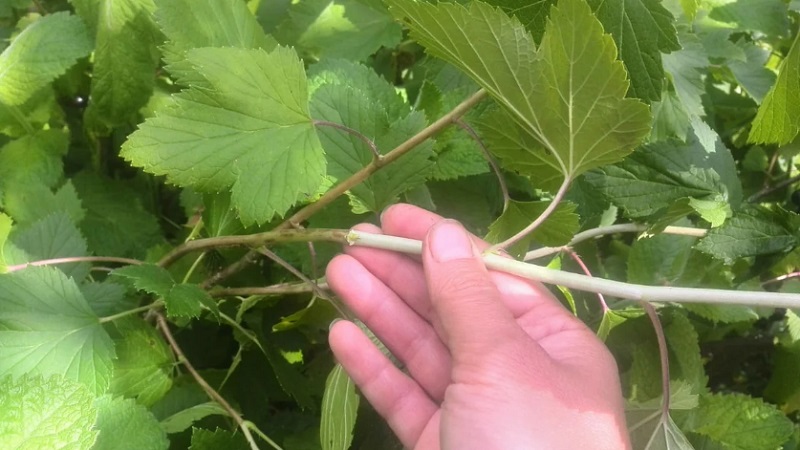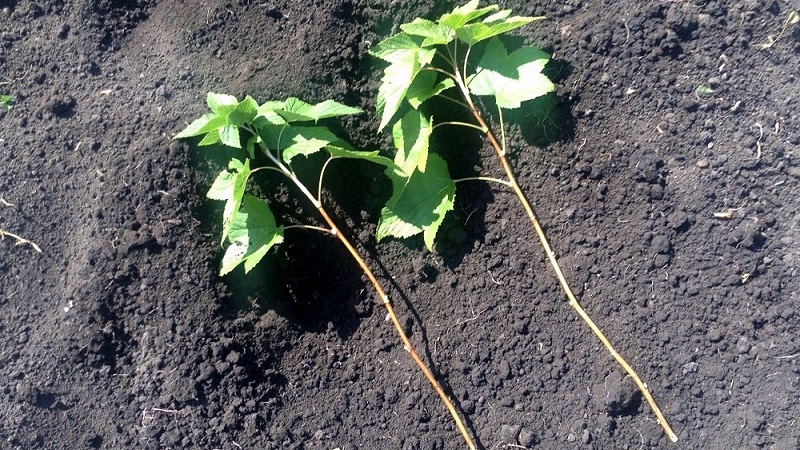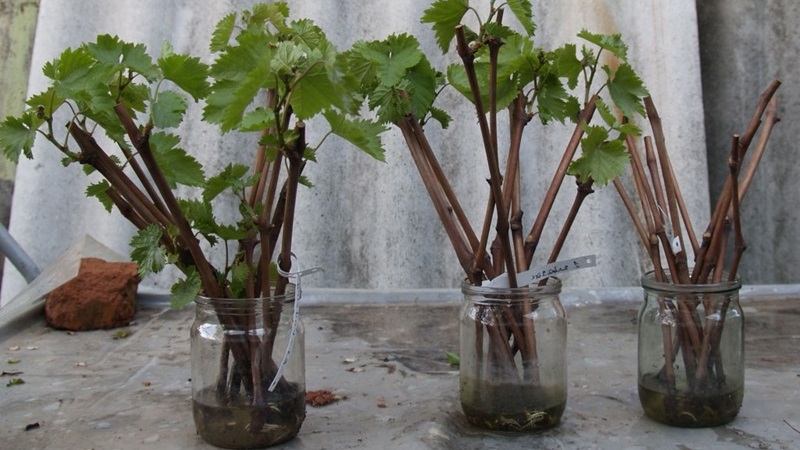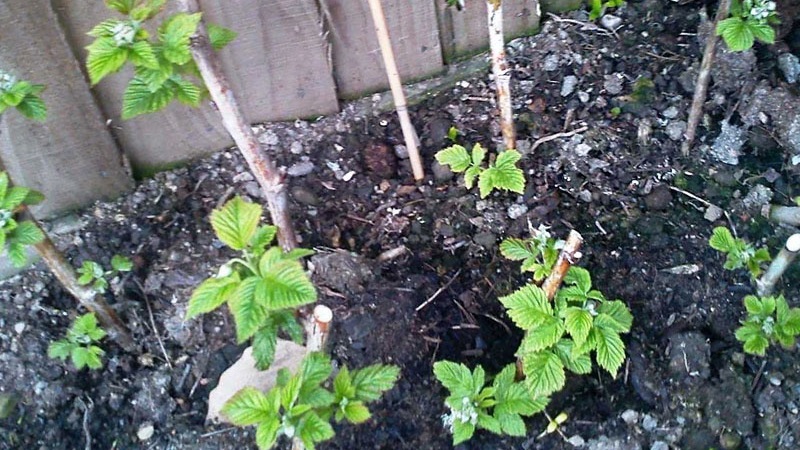Step-by-step guide to propagating currant cuttings in summer
Reproduction of currants is a laborious process. One way to get new berry bushes is to cut mature, healthy plants. For this they use green or lignified shoots, pre-cut them from fruitful bushes and root them. Consider how to properly propagate currants with twigs.
The content of the article
Is it possible to propagate currants by cuttings in summer
If gardeners did not have time to propagate the currants in the spring, they start the procedure in the summer.... In warm weather, cuttings root faster and adapt to climatic conditions, which is beneficial for the root system and the plant as a whole.
It is recommended to propagate currants at the end of June or in July: during this period there is a large selection of young shoots.
Points for and against
With the help of cuttings, summer residents get a rich harvest red, black and white currants. This way of breeding does not require special agrotechnical skills. All that is required are young green or lignified stems. The shrub retains all the varietal characteristics of the mother plant, is distinguished by strong immunity and quickly takes root on the site.
The main disadvantage: the planting material is contaminated... It is not always possible to determine this by external signs, therefore, symptoms of diseases can appear only after planting currants on the site.

Terms of the procedure
The first time the currants are propagated in early July... When choosing a date, pay attention to the weather conditions: it is better to do this in the morning, when the air temperature is no more than + 20 ° C. It is forbidden to carry out the procedure in rain or strong wind.
If it was not possible to propagate the currants in July, the event is postponed to the first half of August.
Auspicious days
In order for the cuttings to take root better on the site, some summer residents choose days in accordance with the lunar calendar.
In the summer of 2020, favorable dates - July 14, 15, 16, 17... These days the moon is in the sign of Taurus. Plants planted with this sign have a large and tasty harvest, the fruits are stored for a long time. Shrubs will hurt less often.
Site requirements
Currant prefers low-lying, well-moisturized and wind-protected areas... There should be no underground groundwater or marshy areas nearby: such conditions provoke the development of fungal diseases. It is recommended to plant plants along the fence. In this case, it is important to follow the planting scheme: the distance between the bushes should be at least 1.5 m, between the bushes and the fence - at least 2 m.
Red currants are planted next to onions, gooseberries, herbs - such a neighborhood has a beneficial effect on the development of cultures. It is not advised to place red currants next to plums and cherries: shrubs need a different soil composition. Suitable neighbors for black currants are honeysuckle, blueberries, garlic. Unsuitable - red currants, raspberries and gooseberries.
Soil preparation
Currant loves slightly acidic and loamy soils... The earth should be light and nutritious. For summer reproduction, the soil is prepared since spring: the beds are leveled so that there are no pits and depressions.
Attention! Currants do not take root well on acidic soils.If the acidity level is higher than 5.5 pH, lime is added to the soil at the rate of 0.5 kg per 1 m2... Before planting, plant debris, debris, foliage are removed from the garden.
2 months before planting, the earth is dug onto a shovel bayonetafter fertilizing it with organic and mineral agents. 1 m2 it takes about 3 kg of manure or compost, 100 g of superphosphate or 30 g of potassium sulfate.
Selection and preparation of cuttings
For reproduction, choose green or lignified cuttings.... The former are suitable for experienced summer residents, as they are planted in a greenhouse or greenhouse. Reproduction by lignified cuttings is used by novice gardeners.
Cuttings for planting are harvested in 2-3 months, their length should be no more than 20 cm, and their thickness should be about 10 mm. Shoots are cut in the morning or afternoon. They keep well if they are wrapped in a damp cloth after trimming.

When preparing cuttings, the following recommendations are observed:
- the cutting is separated from the main shoot with a penknife;
- the places of the cut are lubricated with garden varnish so that infections do not get into the bark of plants;
- foliage is removed from the shoots and the dry top is cut off.
Rooting methods
There are several ways to root: in a jar with water, soil and substrate. Let's consider them in detail.
In water
This is the easiest way to root black and red currants.... The cut shoots are placed in a glass jar with room temperature water. There are 2-3 cuttings for 1 three-liter container. Water is poured so that it covers the 2 lower buds. After a week, tubercles will appear, from which roots will soon grow. Buds form on the cuttings - they are cut off so that no energy is wasted on flowering.

During rooting, the water in the jars is regularly changed so that it does not stagnate... Banks are placed on the window, where direct sunlight does not fall.
In the ground
For rooting in the ground, I prepare the ground in advance: cleaned from debris, dug up and fertilized. The beds should be free of stones and grass. Cuttings are buried in moist soil at a distance of 20-30 cm from each other. This is done in the spring, in April-May, when the snow has completely melted and the air temperature is set at + 18 ° C.
In July, cuttings are planted in individual holes. This method requires more energy and time, so most summer residents prefer rooting in water at home.
In the substrate
In the substrate, cuttings root quickly, they grow healthy and productive bushes... The substrate is sawdust, peat, sand, coconut fiber. All components are bought in a garden store. They are placed in a clean glass or plastic container and moistened with water. The cuttings are placed in a container at a distance of 10 cm from each other and at an angle of 45 °. Cover the currants with polyethylene and place them in a sunny and warm place.
Attention! Rooting takes about 3 weeks. At this time, it is important to water the cuttings daily, maintain the air temperature above + 20 ° C, and ensure the availability of sunlight for at least 8 hours a day. The swelling of the buds and the brightness of their color indicate that the cuttings have taken root.
With added root stimulants
To accelerate the growth of cuttings, root formation stimulants are used... For planting the cuttings in the ground use "Kornevin". The cut of the shoot is dusted with powder and placed in the ground. Use the remedy once: an excess of the stimulant will destroy the plant.
For rooting in water or substrate, use the drug "Heteroauxin"... Dilute 10 g of the preparation in 500 ml of water and mix. The cuttings are dipped in the solution for 15 hours. Then they are placed in water or substrate. It is forbidden to use several stimulants at once.
Interesting on the site:
At what distance are currant bushes planted from each other
How and what to spray currants in the spring from pests and diseases
Cutting currants with green shoots
Cutting with green shoots only gives results in mid-September... It is by this time that the root system will get stronger. Green cuttings 15 cm long are cut from the tops of annual shoots. The upper and lower cuts should be oblique. After they are rooted in water or a substrate, at the same time they prepare a place for planting. For green cuttings, the best option is greenhouses or greenhouses located on the east-west side of the site.

Cuttings with stiff shoots
Annual shoots are used as such shoots.... They are cut from healthy and productive currant bushes. The length of the cutting should be 12–15 cm, diameter 6 mm. The longer the shoot, the more nutrients it contains. When cutting, a sharp cut is made in the upper part at a distance of 1 cm above the kidney. Place the cutting in a substrate or water before planting on the site.
Landing
Cuttings are planted in the early morning... A drainage layer of humus and sand is poured at the bottom of the pit. The shoots are placed in the prepared soil at a slight slope so that 2 buds remain above the ground. The soil around is carefully tamped with hands to avoid air accumulation between the ground and the cuttings.
Attention! Before planting, the cuttings are examined again for signs of disease. Only healthy shoots are left without spots, plaque, color changes.
The plant is watered abundantly with warm water and a layer of mulch is poured: straw, peat, sawdust.
Further care
After planting the plant watered regularly and feed... The shrubs are moistened every 5–7 days, and they consume about 5 liters of water. Previously, it is warmed up in the sun: watering with cold water increases the risk of developing diseases. It is not recommended to use water from the swamp, as it contains pathogens.

Currant responds well to drip irrigation or sprinkling - the bulk of the moisture should fall under the root. Before moistening, the soil is loosened to a depth of 5–7 cm, after which it is mulched. The mulch will keep moisture from evaporating.
Attention! Immediately after planting, the currants are sprayed with a solution of ash or Bordeaux liquid. They increase resistance to insects and diseases, strengthen immunity and frost resistance.
Young currants are fertilized with mineral and organic means... Nitrogen-containing dressings are used: they give strength for the development of shoots and leaves, stimulate root formation. It is recommended to use urea, ammonium sulfate, ammonium nitrate, sodium nitrate. Fertilizers are applied to the ground or on a leaf, depending on their form (liquid, solid, powdery).
Nuances for black, red and white currants
Red and white currants are not as demanding on moisture as black, so any methods are suitable for its rooting. Black is sensitive to drought, therefore it is recommended to root it in water, having previously treated it with a growth stimulant. Pay attention to the composition of the soil: any land is suitable for planting red varieties, for black and white varieties - loose, slightly acidic, pre-fertilized with organomineral complexes.
For winter hardiness and immunity, red currant is superior to black, therefore, before planting, it is recommended to pay special attention to how often the mother bush was sick. It is better to choose cuttings from a plant that did not hurt at all.
Experienced gardening tips
To root and grow currants without problems, novice gardeners pay attention to the advice of experienced summer residents:
- for cutting cuttings, choose productive bushes no older than 5 years;
- besides a knife, use a sharp metal garden pruner;
- disinfect tools with a solution of potassium permanganate;
- work with cuttings with gloves;
- when cutting several varieties, immediately separate them from each other so as not to be confused when planting;
- make cuts from the bottom of the shoot, stepping back from the bottom sheet 0.5 cm;
- Prepare even beds with wire and pegs.
Conclusion
Reproduction of currants by cuttings in the summer begins with the preparation of shoots.For planting, choose a branch about 15–20 cm long and 10 mm in diameter. It is cut with a garden pruner, wrapped in a damp cloth. Rooted in water, soil or substrate.
To make the stalk take root better on the site, use growth stimulants. Currants are planted on slightly acidic fertilized soils, the distance between plantings is 1.5–2 m. Plant care consists of watering, fertilization, treatment against diseases and pests.